The Bright Solar Futures Program recently launched a Solar Lab at Philadelphia's Frankford High School for students interested in solar vocational training. At last week's Construction Tech show video, Micah Gold-Markel shared his experience teaching at the lab and developing the Solar States' Find Your Power curriculum. In addition to installing solar arrays for schools, homes, and commercial buildings, Solar States works to connect students from the region with green energy job opportunities. You can read the transcript for the video below.
Zack Semke:
Hello, and welcome to Construction Tech, presented by Passive House Accelerator, a catalyst of zero carbon building. We're happy you're here. We welcome all comers to our exploration of how to slash the greenhouse gas emissions of our buildings, and make them more resilient to the extreme temperatures, wild weather and grid insecurity caused by climate change. With our co-hosts, Kevin Brennan, Shannon Pendleton, Shaun St-Amour and Mark Wille we produce this weekly series to dive into the details of Passive House Construction practice, with a technical focus on technique and technology in the field. New to all of this? Please visit the Passive House 101 section of our website to get started. With that, please enjoy Construction Tech, and pose your questions in chat for the discussion session following the presentation. Thank you.
Micah Gold-Markel:
I was so hyped up by that intro that I just wanted to jump in and start talking. I was like, "Oh man, this is awesome. This thing is rocking. I'm ready to go."
Shannon Pendleton:
Perfect.
Micah:
So, thank you so much for having me this evening and it's really great and a lot of fun to talk about solar education, the solar industry as a whole, and some of the exciting work that we've been doing. I have to start by giving a shout-out to some of our partners. There's the Philadelphia Energy Authority...oh my goodness, we really wouldn't be here without them; Philadelphia OIC; as well as the ECA. That's the Energy Coordination Agency here in Philadelphia. They're all about weatherization. There's also our good friends at Bright Common, as well, and then the school district of Philadelphia. I have my man Jordan Crowley here, as well. He's our teacher at Frankford High School. So some of you may see the image or may have seen the image that was behind Shannon of our school cutting the ribbon at the Frankford High School solar lab, and let me tell you, this was an amazing experience, okay? First off, we've been waiting for so long to open this lab. We had planned to open it last year. Of course, this strange thing happened called COVID-19 happened, and disrupted our whole idea of starting the school year off teaching in this fabulous lab. We had spent all this time designing it, putting it together. We've got this mock roof in there. We've got all this cool technology. We've got solar panels, we've got racking, we've batteries, we've got inverters, and we're like, "We're going to get these students really pumped up. They're going to be totally hands on. That's the whole goal of this."
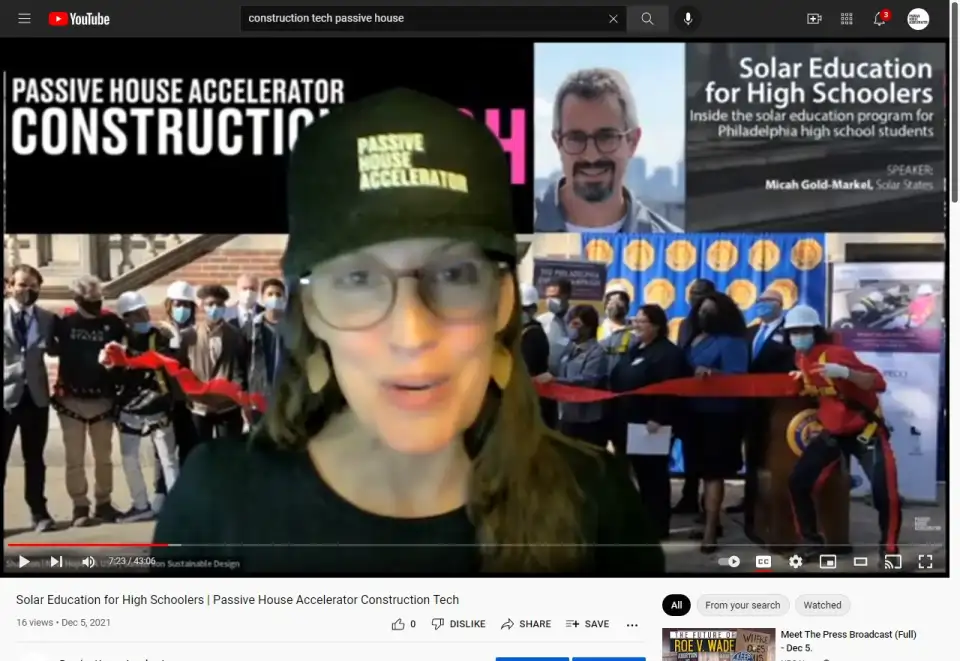
As you'll see a little bit later, we've done all of this work on creating a curriculum around this. This was also funded in large part by the Department of Energy, who gave us a grant to do this solar as a vocation curriculum for the State of Pennsylvania. It's incredible. It's called Bright Solar Futures. I'm going to share some of it, actually a little sneak peek, because we're not quite there publishing it yet, but it's going to be online and available for everyone to use. It's over a 1,000 hours of solar education so that we can have schools in the State of Pennsylvania, in any state throughout the union, have solar installation as what's called a CTE or career technical education track at their high school.
And the idea here is that we want high school students to be able to come out if they choose to not go to college, which let's face it, not everyone's going to go to college. I want people to go to college, I think it's a great choice, but not everyone is going to do it, myself included. And we have to have great jobs in the green collar economy waiting for these folks. How can we do that? That's through solar education at the high school level. And I like to say, if we can do something here in Philadelphia, that we can do it anywhere. This is one of the most challenging environments to get things done. We've got a huge school district. Unfortunately, we've got a lot of issues with poverty, with attendance; you name it, we really deal with it. I'm sure Jordan, he can pitch in and say, "Hey, there's a lot of issues that come up, but we're working our way through this, and we're figuring out a way to make sure that these students are exposed to solar and they do know the vocation of installing solar." That's really different from, I think, a lot of the classwork that's out there. I myself, when I looked for classes got some hands-on stuff, but it wasn't the focus a 100%. A lot of it's theory.
Now, we want students to learn theory, and there's a lot of theory in this class, but there's a focus on getting hands-on. It's sort of the reverse of what you would normally think of. Usually you learn the theory first, right? You say, "Well, energy comes from here. You have to do this. You have to do that. You have to understand how energy is converted from one source to another and how it's used." All that stuff is extremely important, but we were finding that a lot of the students in inner city neighborhoods, which is where I'm from, weren't grasping on to that theory right away because it didn't connect with their everyday lives. And so we wanted to find a way to make that connection, to make it so that we make this relevant to their everyday lives. And boom, this is what we're doing. We decided to flip the script to start with hands-on to say, "Hey, this is how you put this stuff together."
I remember one of my clients once said, "Solar, I get it. It's like adult Legos." I said, "Oh my goodness, that's kind of right. You just kind of snap these things together and they work." And then there's this whole beautiful theory about why and what we're doing. So there's a lot to talk about this evening for sure. Shannon, should I just keep it rolling from here and then I'll pass it back to Zack?
Shannon :
Absolutely, yes.
Micah:
All right.
Shannon :
Great kickoff. And thank you Jordan for joining us. I know we've got you here for a limited amount of time. Everybody give Jordan a warm welcome. And yeah, feel free to share your screen. You should have permissions.
Micah:
Oh, wonderful, wonderful. Well, one of the things that I'm super excited about, as I said, is the classroom. But before I get to the classroom, I want to talk about how we actually got into the classroom. And that's really through Jordan's perseverance. The first year was a total curve ball. I mean, it was like, nobody expected this COVID thing to happen. We had written, as I said, this fairly in-depth syllabus with this lab in mind. We're thinking, "Okay, we've got a solar lab. How can we utilize it in every piece of our coursework? What can we do? How can we make this the most dynamic possible?" And then it all changed. All of a sudden we got told, "Okay, nobody's going into the classroom anymore." And we're like, "Oh wait, wait, what?" All of this stuff is going to have to go out the window and we're going to have to think about how it can all be done online.
And none of us, none of us were even remotely ready to consider that. I mean, it was like a total shock to the system. But we had a really innovative teacher and that's where Jordan Crowley comes in. He really started looking at the syllabus and found that it was over some of the student's heads, unfortunately, and that it wasn't connecting. He had to just do you know what we call in the solar industry or in football, a flea flicker. He decided to change the play up. Instead of running the ball, he was going to toss it back to the quarterback and go deep. And you know, he really tried his best to engage the students online.
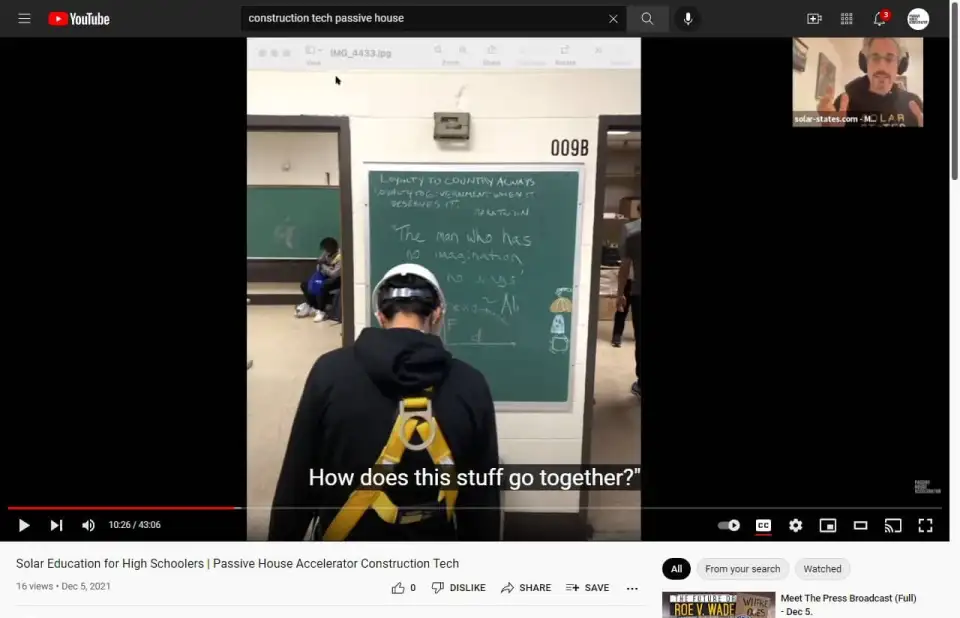
Now, keep in mind, these are students. These are teenagers who are not required to turn on their cameras when they're on the Zoom class. Zoom class is really the only thing that we can do. And so my goodness, Jordan had to sit there and figure out ways to engage the students online. And he managed to do this for an entire year in such a way that we got students back in year two and we were able to open the classroom up. And so this year we started having students in the classroom. Hopefully you can see an image of the chalkboard there of us wearing our PPE.
That's where we start, right? We want to lay out all of the safety gear for the students, but we don't say, "Hey, this is safety gear. You got to put it on like this and do this and do that." No, what we try to do is say, "Look at this gear. What do you think it does? How do you think it works? How does this stuff go together?" Because we want to get students really imagining things. And sometimes they come up with things that really surprise you. And you're like, "Oh my goodness. Well, this isn't used that way, but maybe there's a new product there. Maybe there's something that can be innovated on that, 'Hey, you could start a new business doing.'" My goodness, wouldn't that be amazing?
So this isn't just about being worker bees per se; it's also about being innovators. And I like to say to students, when I come into the classroom, "This is a problem. Climate change is a problem that we're solving through solar energy and through non-carbon emitting energy sources. But guess what? There's also a lot of money to be made." And that's what connects with a lot of these folks from the inner city, you know? Yes, climate change is a big problem. Yes, I feel it is going to be the problem that is going to be facing our children. But people have immediate needs that need to be met, especially people from low income households.
So, they come into it and they think, "How am I going to put food on my plate tomorrow?" And I tell them things like, "Guess what, Solar States, if you know nothing, when you're starting off, you're getting paid $16 an hour. You're going to get a 401(k) and healthcare." Guess what? That makes a big difference. And then when people see that they can come through the Solar States family and really learn and progress and grow, it makes all the difference. So, that gets them started in thinking of this.
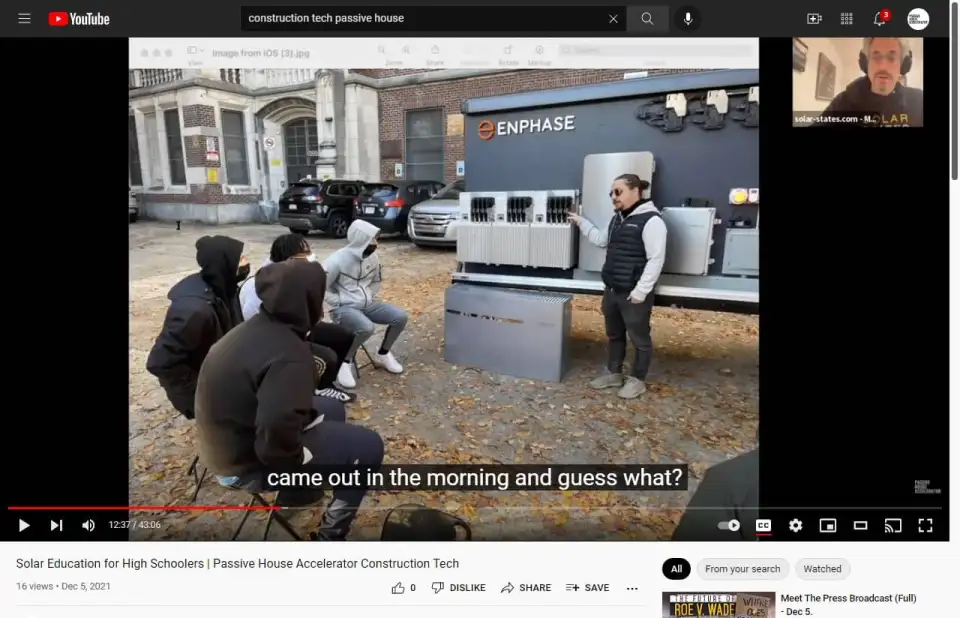
Then we get in really innovative guests like the wonderful folks at Enphase who come with this truly incredible truck. I mean, the Enphase truck is the coolest thing in the world. And I have to give a shout-out to my man, Andrew at Enphase. I met him at training. I said, "Andrew, man, this would be great to bring to our classroom." And Andrew goes, "Oh my goodness. I would love to do that. I would love to bring this out." And I said, "Andrew, man, this would be so special for the students, it'd be super special." So Andrew picked a day, came out in the morning, and guess what? It's a COVID-friendly classroom. So this is another technique that I think educators can use. As they're thinking about, "Hey, COVID might limit our classroom time. How can we meet outside? Bring the classroom outside?" And so having companies come and present using their resources is a great way of having an outdoor classroom and something that I wish we were able to think of sooner to engage students in doing this.
And as you can see here, Andrew was really psyched up to meet a lot of the students. All the students are standing around, they're all serious. Andrew's the one like this. The one only adult in the whole team is the one making the hand symbols and everything in the picture. But this was really cool, because it got to give the students exposure to not only the concept of micro inverters, how they work with solar, for those of you who might not be aware, traditionally in solar we've used string inverters, where you have a whole string of solar panels, and then they go down to a single inverter where that DC current gets inverted to AC, which gets used in your house. Well, Enphase innovated on this and they came up with a microinverter that sits underneath each individual solar panel on your roof so that you can get power output individually.
And this is neat because it helps to comply with new code for what's called rapid shutdown, where you have to be able to shut off each individual solar panel on a roof, but it also means that you're dealing with AC current instead DC coming right off of the roof. Very cool concept. But how does this work with batteries? Because we know traditionally that batteries output DC current as well. Well, Enphase came up with a really creative solution where they put their microinverters and paired them with batteries as well. And those are special microinverters that can now take AC current and convert it to DC, and then when the batteries need to be discharged, they can invert that DC to AC to be used in your house.
So we're seeing huge innovation in this space with the release of the IQ8s actually, you can have a microgrid right at your house, right from solar. You actually don't even need batteries. It's amazing. It's mind-blowing. One of the biggest problems that I've had with clients is they say, "Okay, so I'm getting solar. So when the power goes out, guess what? I'm going to be the only one on the block with power." And they say, "Oh no. You have a grid tied solar array. So actually when the power goes off, your solar goes off. I'm sorry about that." One of the reasons for that is because, if you're creating power that gets pushed back onto the grid and there's a power outage, if there's a line person working on the line there, they could get zapped by power coming back on the grid.
But Enphase has come up with a way to exactly meet the loads of the house and to isolate the house from the grid, so that solar can stay active and form a microgrid right at your house and when there are these power outages, you can still get some power. This is what these students were learning that day. I mean, it's pretty advanced stuff and they're getting right into it. So I was really, really excited about that opportunity. And I think there are lots of equipment vendors out there that can enrich the classroom.
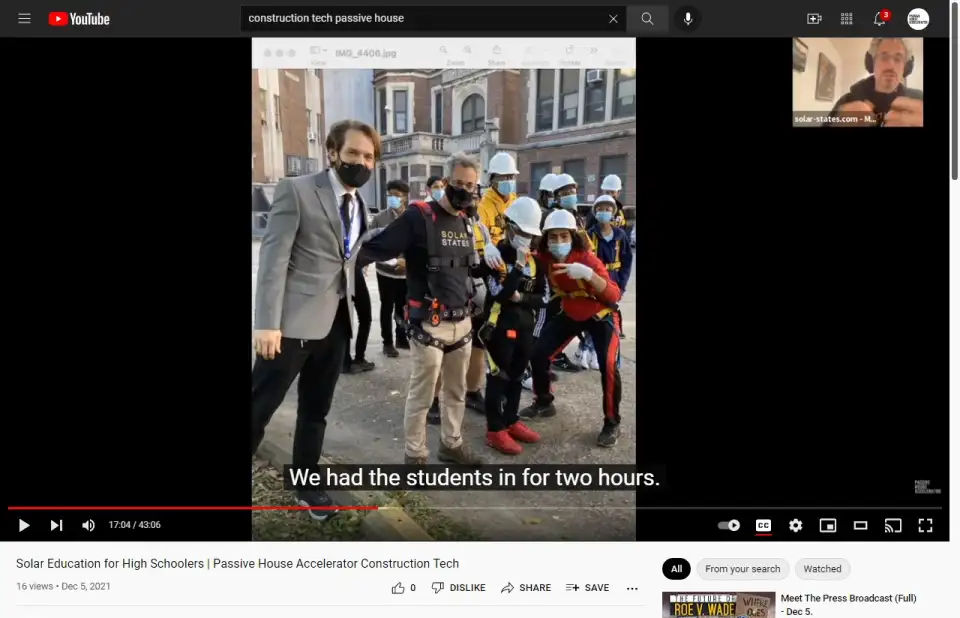
Here's Jordan with the class. We actually were lucky enough to have the mayor and a lot of City Council out because this was one of the first classrooms of its kind in the entire state of Pennsylvania at a high school. Usually these are sort of outside of schools, right? They're independent education organizations. This is a public high school right here in Philadelphia.
Now, if I didn't say there have been some significant challenges with this, I'd be lying to you. Students learn at their own pace. You really have to be open to where they're at. And there are lots of different levels of students. Actually, I was reminded of that a bit today. We had the students in for two hours, we were actually teaching them how to bend conduit, half inch EMT conduit. Jordan and I were standing there with the pipe bender, showing them how to do 90s and saddles and all sorts of different bends, like offset bending of conduit. Some of the students were really getting it right away. Some of the students were just destroying pipe, and they're pulling back, and they're not quite getting it.
And we had this one kid walk in. He was an hour late and I'm all frustrated, "Hey, you're late. You're behind." I say, "I need you to bend this stub up right away." He looks at the instructions, he gets it. Boom. He bends a perfect stub up, right out of the gate. It's one of those things where some students are going to be really fast to grasp this stuff, and other students are going to need to take their time and get the tactile feel for what we're doing. Our job as educators is to meet the students where they're at and figure out a way to make this a challenge for everyone and to make exciting for everyone involved.
I'm very happy to say that we have women participating in our class who were interested in getting into the solar installation field right away. I was really hoping, I was saying to myself, "Man, I hope some women sign up for this class," but I was a little bit worried because, let's be honest, construction has been very male-dominated. But we've seen a lot of women have interest in this field, both at Solar States and now at the school level. And I'm really excited to see a revolution of women coming through the trades to really the industry.
Not only that, we're seeing a lot of interest in low income neighborhoods. We recently installed 50 LMI, low- to middle-income solar installations in the City of Philadelphia through an innovative financing technique with the Philadelphia Energy Authority. And that was a huge success. So we're really, really excited about the future of solar.
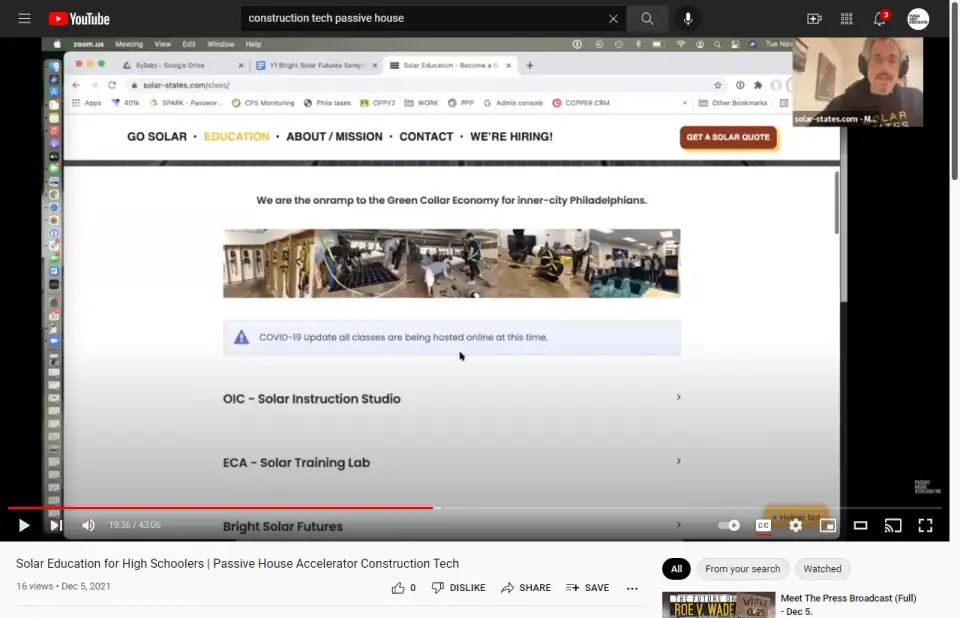
A little bit more about Solar States and the class trainings that we do. We have several labs that are set up. As you know, we have one at Frankford High School, but we also have a training lab at the ECA and Philadelphia OIC for young adults who want to get into solar. Hopefully now you can see some of the images. Again, we have a little locker room where you can get your PPE on. Even in our training rooms, we like to say, "Look, you got to treat this like real life. You got wear your PPE, your fall arrest systems, your hard hats. Get your gear on." And we have training facilities at the ECA and at Philadelphia OIC.
The goal here, again, is not just training for training's sake, but we hold job fairs at the end of all of our classes. We hire pretty much exclusively through our program. I'm going to talk about that a little bit as we go down the list here. So we've developed a much shorter curriculum. I explained the Bright Solar Futures curriculum is over 1,000 hours at the high school level. We also have the Find Your Power curriculum, which is more of an 80-hour, and that can happen over three to four weeks. Sometimes we stretch it out to six weeks where we're doing lots of trainings with young adults.
We pre-qualify people simply by saying, "Hey, are you interested? Do you want to learn this stuff?" And then we ask, "Are you able to lift up a solar panel or lift a ladder?" We do a little test with that. "If you can do that, then we're going to take you in and we're going to make sure that you get the skills needed to have a jump start on getting into this industry." Well, what does that mean? That means you are not only are learning the field stuff, and we have certifications for making what's called field made connectors, MC-4 crimps, where you're doing some of the actual hands-on work with solar, we also have a little certification firm making sure that you understand electrical safety, that sort of stuff.
So we make sure that there are little checkpoints along the way to ensure that people are learning the skills they need. But then we also take a more broad look and we say, "Hey, would you be interested in becoming a NABCEP associate? That stands for the North American Board of Certified Energy Practitioners. It's a terrible name. It's such a mouthful to say. NABCEP...It doesn't even roll off the tongue, but it is the gold standard for certification in the solar industry. They do an incredible job of making sure that people are ready to enter the solar industry, so when you have that NABCEP associate's credential, it means something. It's also a step to getting your NABCEP PV installation professional. That's the certification that I have. It's a very difficult test to take and to pass, but taking that associate's quiz is something that we bake into our classes so that students can graduate with a credential. The other thing that we try to ensure that students have as they're coming out is at least a bare minimum of their OSHA 10 certification, because you need to have safety on the work site. Philadelphia requires anybody who's stepping onto a work site to have that OSHA 10 certification as a baseline. If you're going to be a foreperson, then you have to have at least an OSHA 30 certification as well. And some of our students end up going for that as well.
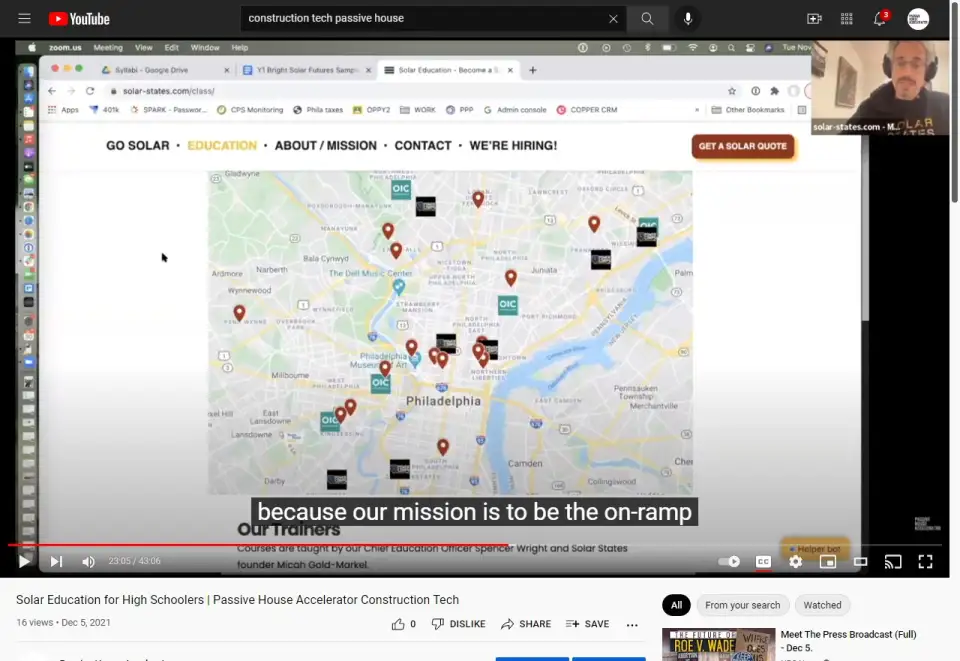
So what you see on your screen right now is a map of where our employees live in the City of Philadelphia. And this is something we're very proud of because our mission is to be the on-ramp to the green collar economy for inner city Philadelphians. So where you see a dot, that's where one of our employees lives. But where you see a logo, either OIC or PowerCorps PHL—I'm not sure if I gave them a shout-out, but PowerCorps PHL is another very important partner that we work with here in Philadelphia—then that means one of our employees has come through the program that we ran either with PowerCorps or OIC. And they're now working with us and it shows the neighborhood that they live in.
So we're really focused on making sure that the jobs are being distributed equitably throughout the City of Philadelphia. That's really important. When I started 13 years ago, the solar industry was very white male dominated, but we need to make sure that these jobs and everybody is being included. And that goes back to our mission. And our mission is to be the on-ramp to the green collar economy for inner city Philadelphians, and that's based on Van Jones' book, The Green Collar Economy. I don't know if anybody here has read this book. It's an incredible book that came out about 13 years ago. It inspired me to start Solar States. It inspired me to have this mission.
I got a chance to really talk to Van Jones as he was going on a book tour about this, and in his book, he says, "The green wave can lift all boats." That line just got me. It got me in the heart. I said to myself, "My goodness, my goodness, isn't he right? The green wave can lift all boats. It can be something where we all prosper together. We all have good paying jobs together." And he said, "You know what? This change in our economy, it's not a nice thing; it's a necessary thing. It has to happen. And if it happens in the way that previous economic revolutions have happened, we're going to fail because it can't be just centered with some folk. This is an environmental disaster that could happen. We all have to have a part in this. We all have to be responsible, and we all have to benefit."
And that's what our goal is here with these training programs. It's to make sure that people have that opportunity. That's what our curriculum is really geared toward is saying, "Hey, if you're interested in this, we want you in this industry. We want to make sure that you can find a job here." One of the reasons why the solar industry is what it is today is because it's fast growing, right? It's super fast growing, much like Passive House Construction. Many years ago, barely anybody had heard of Passive House standards. I mean, who knew? Who knew about insulating your housing, making it super tight and all of these concepts that are so important to conserving energy.
But now, as we're becoming more aware of this stuff, more people want to do it. More jobs are available and we need more people who are ready to come out and execute really important and detailed plans for houses. And that's where it starts. It starts at the planning level. It starts at the education level. We then take that and we go out in the field and we execute. And that's what we're all about.
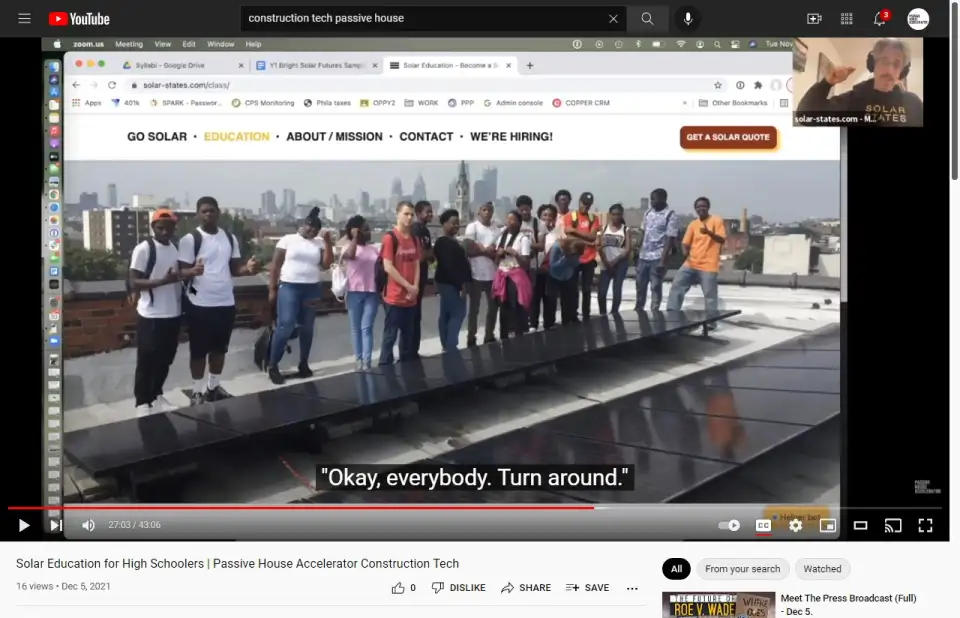
Here you can see one of our classes on top of the Crane Arts building. This is an installation we did 11 years ago. It was one of the largest in the city of Philadelphia, okay? And it's 444 solar panels on the roof of the Crane Arts building. And I take the students up there so that they can see the sea of solar panels on the roof. And then I say to all of them, "Okay everybody, turn around." And they turn around and there's this amazing view. You can see it a little bit in the background. It's just an incredible view of the entire city of Philadelphia right there in the background, and when you look at all of the roofs, there's almost no solar on any of them. And I say, "Look at these roofs. What's missing? What's missing?" And they all say, "Oh my gosh, there's no solar on any of them." I go, "I feel like an oil man who's surrounded by oil. There's opportunity everywhere." They all light up. It's like, "Oh my gosh, there is opportunity everywhere. Each one of these roofs could have solar on them." And then you get that conversation. You get that inspiration started. You get it going. And then they all want to get involved. They say, "Okay, all right, I get this. There's a lot of opportunity. How do I get involved? Why, where do I start?" And then we start talking about the economics and how it all works. And they're tuned in from that moment.
Another piece that I like to bring to these students is to connect it to their everyday lives. Talking about energy and environmentalism in the abstract can be very difficult for some people. so you have to connect it. If you say, "Okay, what kind of music do you like to listen to?" And everybody names the type of music they listen to. "Okay, now, what do you listen to it on?" "Okay, I listen to it on some sort of electronic device." At the very basic level, what does that device need to operate? It needs electricity. It needs electricity. Okay, where does that electricity come from? Well, there's a lot of coal fired power plants in the state of Pennsylvania. Guess what? Particulate matter in the air from coal burning is one of the number one causes of asthma, and I ask, "Who knows somebody with asthma?" Almost everybody raises their hand, right? Everybody knows somebody with asthma.
Well, isn't it crazy. Have you ever thought about the thing that you love doing? Listening to this music, using electricity, is making us sick, literally. It's kind of crazy to think about that there's this coal being burned that's giving us asthma just because we love to listen to this awesome music, but there's another way. We can solve these problems in a brand new way. And sometimes those are the hardest ways to solve them. We know how to deliver electricity to a lot of the United States. We know how to generate a lot of electricity, but now we need to think of a new way of solving this problem that's already been solved. And that gets the creative juices flowing in the classroom. That gets these students thinking about how it's connected to their lives.
And as you can see, in this class we have women. We have young men. We have black folks, Asian folks, white folks. Folks of every walk of life: low income, wealthy, college educated, not college educated. You name it, we get them from everywhere. And that's one of the things I love the most about our programs is we're bringing diverse groups of people together who are inspired by solar to get into the industry, to make sure that they can get a great job going forward.
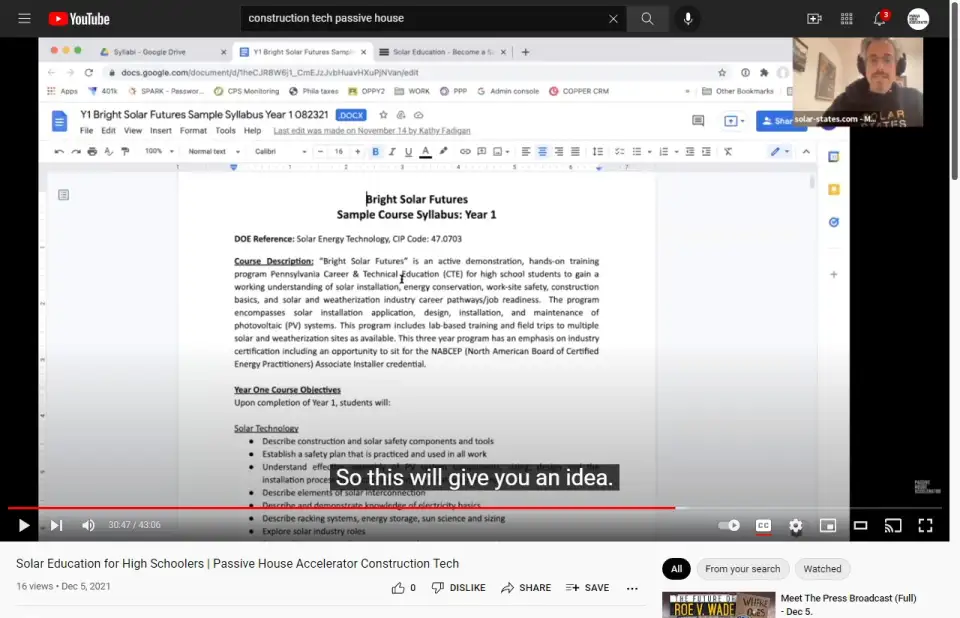
So I've talked a little bit about the curriculum that we use at the high school level. And I'd like to share a little bit of the syllabi that we wrote, just for year one. It's a very long curriculum, over a 1,000 hours, so I'm not going to share all of it. Let me see if I can find the screen to share here. This is the year one. This is a three-year, 1,000-hour course. So this will give you an idea. The syllabus is an outline, but each one of these lessons has a lesson plan to go with it, and then a sort of a description to start at the very beginning. As you can see by the course description, Bright Solar Futures is demonstration-based and hands-on training. That's really the key to the curriculum that we've worked on with our partners.
And you can see that year one we have these goals for the students to be able to describe the construction and solar safety components, tools, safety plan, and so forth. Now, we worked with our partner at the ECA to also integrate weatherization and energy efficiency, because let's not forget, solar is the tip of the pyramid, right? You want to have a house that's super tight. I mean, I'm talking to the converted here, right? Passive house people know you try to use as little energy as possible, and then you get that energy from renewable sources, right? So we want to integrate some of these weatherization techniques into here so that people understand that it's not just about solar energy and wasting tons of energy. You want that super tight house that sips energy, and then you want that energy to come from solar or some renewable sources.
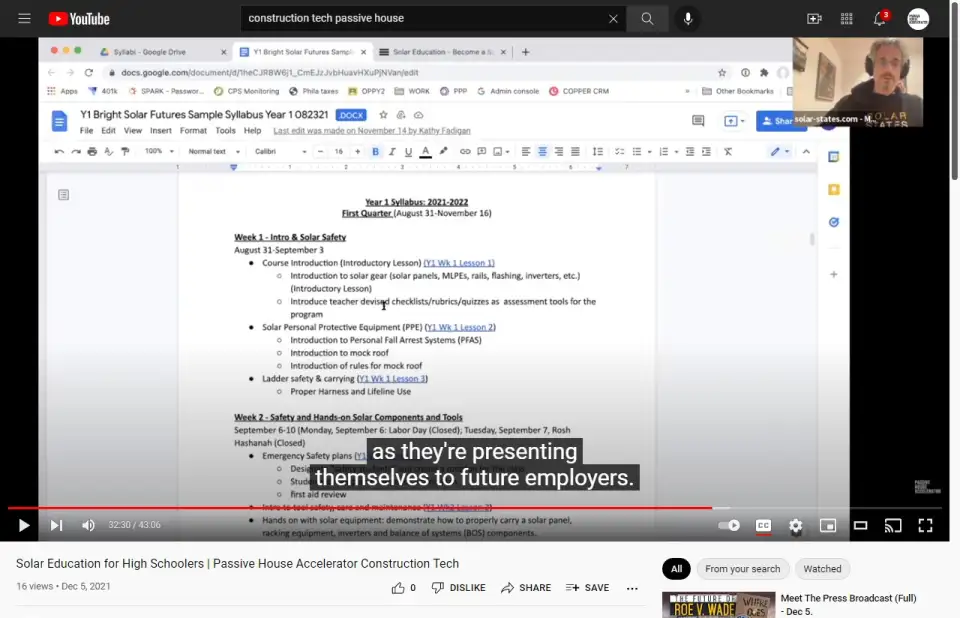
Now, in our particular instance, we also wanted to develop life skills and professional skills for the students. It's very important, because they can't just go out there knowing about solar, but not be able to convey what they know to their future employer, so we teach how to understand how to do an interview, how to present and say, "Hey, I know this stuff." How to be confident with themselves as they're presenting themselves to future employers.
So week one, as I said, we start with safety and these are all links to lesson plans, ladder safety and PPE, personal protective equipment, introduction. Again, we continue with that. There's a lot of education about tools too. It's funny, when I get into the classroom, every student swears, "Oh, I know how to use a drill. I know how to use a hammer. I know how to do that." And then you have them start hammering and they're bending 30 nails in a row, and you're like, "No, you don't. It's about the wrist motion. Keep your eye on the head of the nail. There's a proper way to use a drill. There's a proper way to use a hammer." We go through all of that stuff, and we don't just assume that everyone knows what they're doing.
It's really important to have a mock roof in the classroom. We build all of the mock roofs in our classrooms so that you can have a six-panel solar array set up. And now the really unique thing about the Frankford classroom is, we also have an electrical wall that's energized. It can be energized or shut off so the students are safe, but we can energize it so that we can actually turn the solar array on indoors. The goal we have now is that we're going to buy some lights indoors and be able to fire up that solar array and actually go all the way through commissioning the solar array with batteries in the classroom. I think that's going to be a very unique experience for a lot of the students.
So, we not only practice on the mock roof, but Philadelphia is a town of row homes where there's a lot of flat roofs and ballast weight systems where concrete blocks hold down the solar rather than having mechanical attachments hold it down. They're very popular because there are no holes in the roof. So we not only go through how to install on a more suburban style pitched roof, but we also do flat roof ballast weight training as well. Then we want to make sure we step back for a moment and students have some time to really understand the design in the interconnection requirements for solar. And then we step back again and we say, "Okay, let's talk about electricity basics and the code book and why that's important." And again, we kind of use that time to build up the general skills. So we start hands-on and then we go theory, which is a lot. It's kind of the reverse of the way a lot of folks do it. We go through racking systems. Then we also talk about other roles. We are heavy on solar installation, but we want to let people know, "Hey, there's sales, there's site surveys, there are people who fly drones who are part of this industry. There are lots of roles. If you're not into construction, you can still play a very important role in the solar industry."
And we spend more time on our electricity basics. Then we go over the different types of solar. There's grid type, there's off-grid, there's hybrid systems, and all sorts of stuff that's out there. As you can see, there's weeks and weeks of content here. We go into earth science basics, solar fundamentals, site analysis. So site surveyors, that's a role that we frequently need to hire for. You're not doing construction, but you're going out. Maybe you're flying the drone. Maybe you need to take apart the main service panel so that you can photograph the condition of the electrical systems in the house. These are all things that we're training our students to do. Understanding tilt and azimuth and how they affect production; the different interconnection types; line side versus load side.
And then we do some assessments and practice tests. Now, again, in a traditional school you'd sit there and you'd take your test. You'd be very nervous. "I know Friday's coming up. I got this huge test. I got to study, I got to do this. I got to do that." Well, we wanted to change that rubric. We wanted to change that feeling. So a lot of what we do is assessment-based testing, where you're getting hands-on. Can you install the flashing properly? Can you make this field made connected properly? That's what we're testing you on. Not necessarily, "Hey, can you write the right answer or pick a multiple choice answer on a test." So it's really much more hands-on. Then we go into weatherization. And again, this is where the ECA really did a lot of work. You can see, air sealing and insulation, auditing, applying so that your house is just sipping on energy rather than hogging it up.
There's a big difference between having a 50-panel solar array and a 10-panel solar array. And I'm always inspired, and I tell my students, "I remember the first time I went out to New Mexico and I saw these things called Earthships out there. I mean, these things are incredible. These off-grid houses are super insulated. They're in the ground, right? They use southern facing light." I thought to my myself, "Wow, they're off-grid. They must have these huge solar arrays, right?" But these houses have five solar panels on them and that's it because they're so efficient. They use DC refrigerators and LED lights and they just sip on energy. And it's incredible. It's incredible because they don't have huge heating and cooling needs because of the way they orient the house and the way they're insulated and so forth.
So I make sure that students know, it's not about necessarily more, more, more. It's about how do you conserve? How do you use what you have as wisely as possible? Okay. So as we go through this, we review, we go through the different system types and we make sure that students get exposure to lots of different roles here. And then you can see some suggested time allotments at the end. I don't want to take you through all three years of this. There's a lot of content here. If anybody is interested in learning more, I'm going to put my email in the chat so that if you do want access to this when it comes out, I'll make sure that you get a copy.
That's kind of my spiel for now, so to speak. I was told too that you have a tradition of thanking a mentor, so I want to take a moment to thank a mentor of mine, and that mentor's name is Ron Celentano. Ron is the godfather of solar in the State of Pennsylvania. Ron taught me basically everything that I know about solar. And there's a real funny story I love to tell about how important Ron has been to me in the starting of Solar States.
I told you about that solar array at the Crane Arts that I take students to. Well, that is actually owned and operated by Solar States. So we did what's called a PPA, a power purchasing agreement where we own the solar array and the building owner buys the power. And we did this agreement, right? I had to basically beg, borrow and steel to get the money together to do this project. I mean, it was incredible. I went to bank after bank and I got turned down, so I ended up doing a letter writing campaign to friends and family and borrowed $250,000 through $5,000 to $10,000 loan commitments, and got half the money. And then I had grant money for the other half, but I had to spend the money first. And I went back to the banks and I said, "I've raised $250,000. I have grant commitments for the other $250,000. Now can you loan me the money?" The banks still said, "No way, we won't lend the money." And so I was ready to give up. And then I met this guy who is actually in private equity who had just installed solar on his house. He goes, "I get this." He goes, "I'll loan you the $250,000." I'm like, "Whoa, you have that money?" He goes, "Sure." He goes, "But it's going to be 16% interest."
I was like, "Oh my goodness, oh my goodness, this guy's a shark." But we made it work. We made it work. And we got that project financed and we got the grants in and we didn't have that 16% hard money out for very long. And we got it all done. But the project, to repay the loans over the 10 year period, we were relying on what's called SREC revenue or the Solar Renewable Energy Credits. And at that time they were worth $360. They were really selling for a high value, and we were getting $40,000 in a year in SREC revenue. And I was thinking to myself, "Wow, I'm actually going to do this."
And I remember the day, Ron called me up and said, "Micah, you've got to find somebody who's going to do a future strip for your SRECs." I said, "What's that?" He goes, "That's when you get a guaranteed price for your SRECs, but it goes out two, three, or five years, and it's going to be lower than what they're selling at now." I said, "Ron, I don't want to lose this money." He goes, "Trust me; the SREC market, as much as it can go up, it can go down too." And he found me a guy who was willing to buy my SRECs for something like three or four years at $280 an SREC, instead of $360. I kept saying to Ron, "Ron, I'm losing this money here, man. Are you sure I should sign?" He goes, "Micah, don't gamble with your future. Sign the contract." And so I did and three months later SRECs crashed all the way down to $50 bucks. I would have been complete ruined if it hadn't been for Ron's wonderful advice at that time.
So I got to give a big thank you to Ron Celentano, he's been incredible in with policy and just making sure that the State of Pennsylvania, as well as the United States has great solar policies, constantly pushing forward. So thank you so much, Ron. And with that, I'd like to hand it back to Zack.



